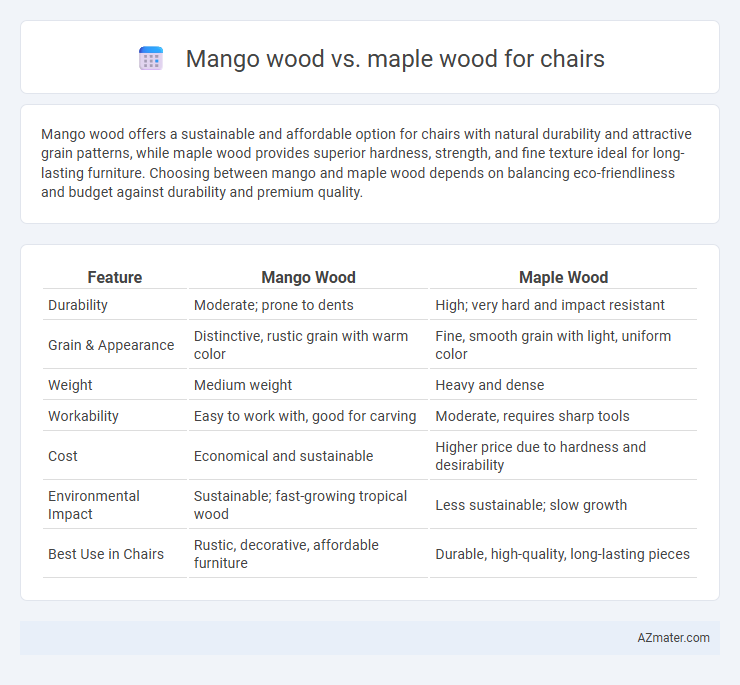Mango wood offers a sustainable and affordable option for chairs with natural durability and attractive grain patterns, while maple wood provides superior hardness, strength, and fine texture ideal for long-lasting furniture. Choosing between mango and maple wood depends on balancing eco-friendliness and budget against durability and premium quality.
Table of Comparison
| Feature | Mango Wood | Maple Wood |
|---|---|---|
| Durability | Moderate; prone to dents | High; very hard and impact resistant |
| Grain & Appearance | Distinctive, rustic grain with warm color | Fine, smooth grain with light, uniform color |
| Weight | Medium weight | Heavy and dense |
| Workability | Easy to work with, good for carving | Moderate, requires sharp tools |
| Cost | Economical and sustainable | Higher price due to hardness and desirability |
| Environmental Impact | Sustainable; fast-growing tropical wood | Less sustainable; slow growth |
| Best Use in Chairs | Rustic, decorative, affordable furniture | Durable, high-quality, long-lasting pieces |
Introduction to Mango Wood and Maple Wood
Mango wood, harvested from the fast-growing mango tree, is prized for its sustainability and unique grain patterns, making it a popular choice for handcrafted furniture like chairs. Maple wood, sourced from the dense and durable maple tree, offers exceptional strength and a smooth finish, ideal for sturdy and long-lasting chair construction. Both woods provide distinct aesthetics and durability but differ significantly in grain, hardness, and environmental impact.
Key Characteristics of Mango Wood
Mango wood is a sustainable hardwood known for its durability and distinctive grain patterns, making it an excellent choice for chair construction. Its natural resistance to moisture and environmental changes ensures long-lasting strength and stability. Compared to maple wood, mango wood offers a unique aesthetic with warm hues and eco-friendly sourcing, providing both functional and visual appeal.
Key Characteristics of Maple Wood
Maple wood is prized for its exceptional durability and fine, consistent grain, making it ideal for chair construction requiring strength and a smooth finish. Its tight grain structure provides resistance to wear and dents, ensuring long-lasting furniture with a polished appearance. Maple's natural light color also lends itself well to staining, offering versatile design options for various chair styles.
Durability Comparison: Mango vs Maple
Maple wood offers superior durability for chairs due to its dense grain and high resistance to wear, making it ideal for heavy daily use. Mango wood, while moderately durable, features a softer texture that may show dents and scratches more easily over time. For long-lasting furniture, maple is preferred for its strength and ability to maintain structural integrity under stress.
Aesthetics and Grain Patterns
Mango wood offers a rich, warm aesthetic with unique, irregular grain patterns that add rustic charm and visual interest to chairs, featuring a blend of yellow, orange, and brown hues. Maple wood presents a smoother, more uniform grain that emphasizes a cleaner, refined appearance with lighter shades ranging from creamy white to pale reddish-brown. Both woods enhance chair design, but mango wood suits eclectic or traditional styles, while maple wood aligns with modern and minimalist furniture aesthetics.
Sustainability and Eco-Friendliness
Mango wood is considered more sustainable than maple wood due to its faster growth rate and the practice of harvesting mango trees only after they cease fruit production, which reduces deforestation. Maple wood comes from slower-growing trees, leading to longer replenishment cycles and higher environmental impact during harvesting. Choosing mango wood for chairs supports eco-friendly forestry practices and lowers the carbon footprint compared to traditional maple wood options.
Workability and Ease of Crafting Chairs
Mango wood offers moderate workability with a fine, straight grain that allows for smoother cutting and carving, making it suitable for crafting intricately designed chairs. Maple wood, known for its hardness and dense grain structure, provides excellent durability but requires more effort and sharper tools during shaping and sanding. Both woods are valued in furniture-making, yet mango wood tends to be more forgiving for detailed work, while maple delivers superior strength and long-lasting chair frames.
Cost Differences Between Mango and Maple
Mango wood chairs are generally more affordable than maple wood chairs due to mango wood's faster growth rate and widespread availability in tropical regions. Maple wood, known for its dense grain and durability, commands a higher price driven by slower growth and import costs in many markets. Cost differences between mango and maple wood chairs typically reflect these factors, with mango offering budget-friendly options and maple appealing to buyers prioritizing long-term strength and aesthetics.
Maintenance and Care Requirements
Mango wood chairs require regular oiling and moisture control to prevent cracking and maintain their rich color, as the wood is moderately porous and prone to humidity damage. Maple wood chairs, being dense and hard, demand less frequent maintenance but benefit from occasional polishing to preserve their smooth finish and resistance to stains. Both woods need protection from direct sunlight and heat to avoid warping and discoloration, ensuring longevity with proper care.
Which Wood Is Better for Chairs?
Mango wood offers high durability and natural resistance to insects, making it an excellent choice for sturdy, long-lasting chairs with a unique grain pattern. Maple wood is known for its exceptional hardness and smooth finish, providing strong structural support and a refined appearance ideal for traditional or modern chair designs. For chairs requiring robust strength and a polished look, maple is preferable, while mango wood suits those seeking eco-friendly options with distinct aesthetics.

Infographic: Mango wood vs Maple wood for Chair
 azmater.com
azmater.com